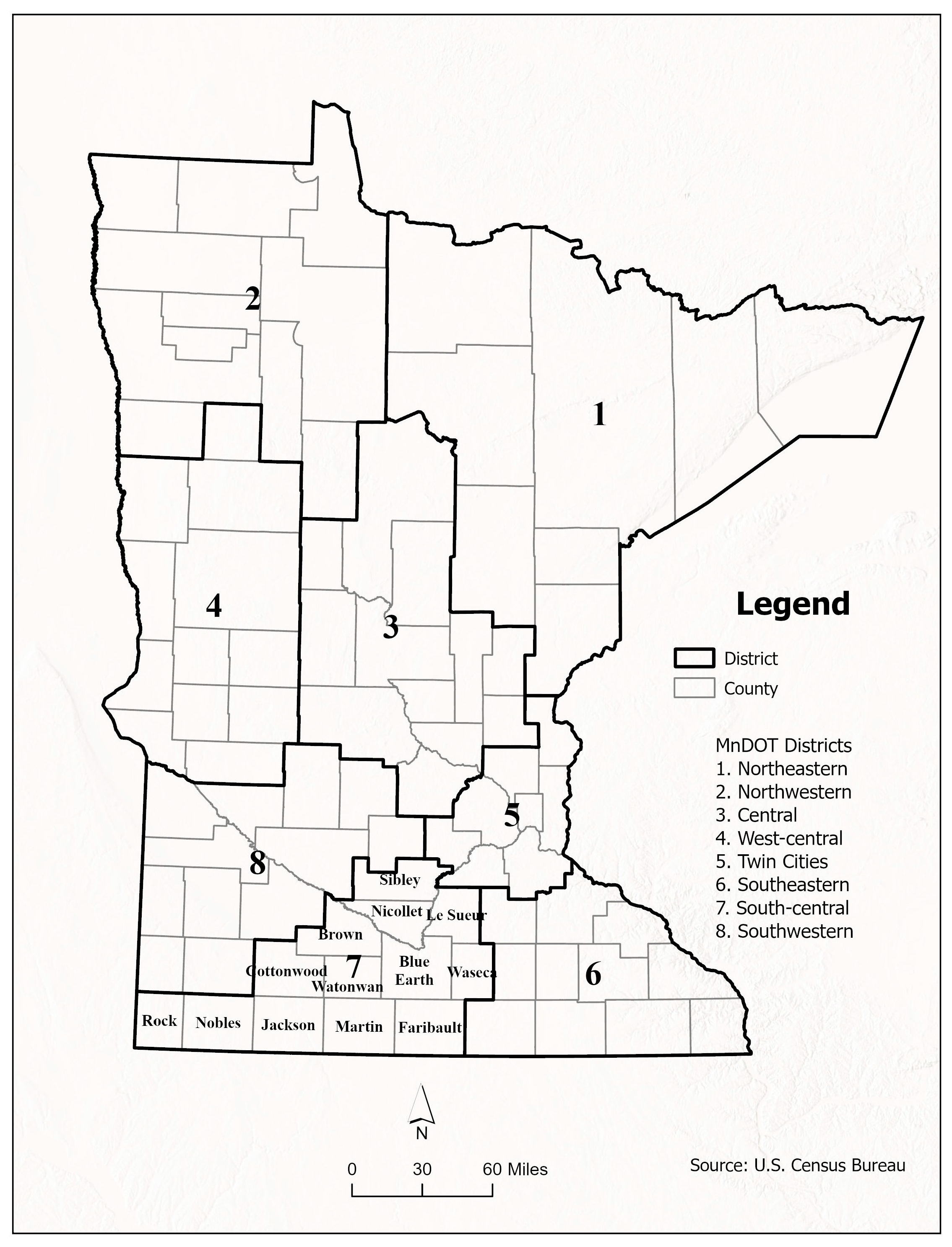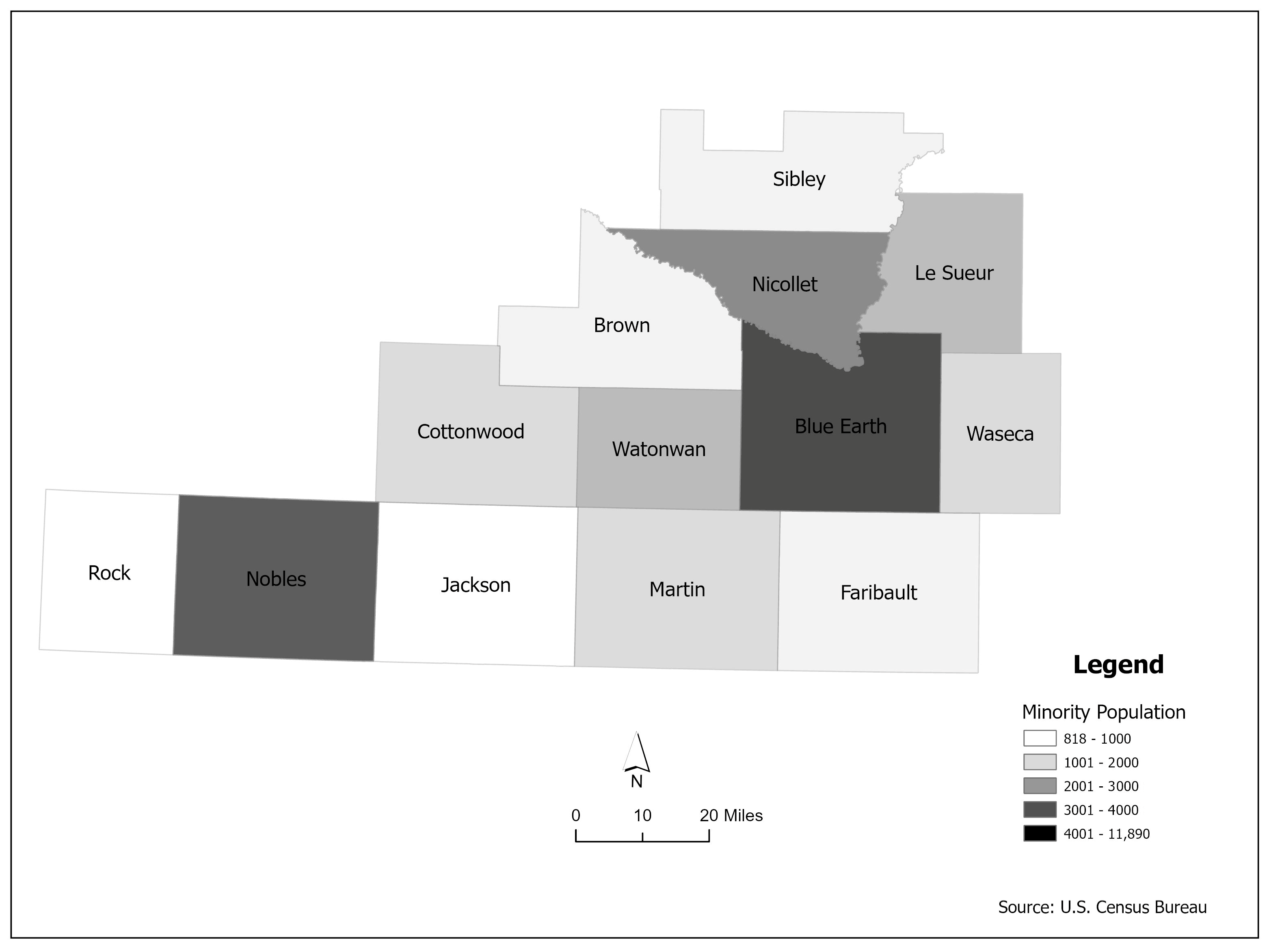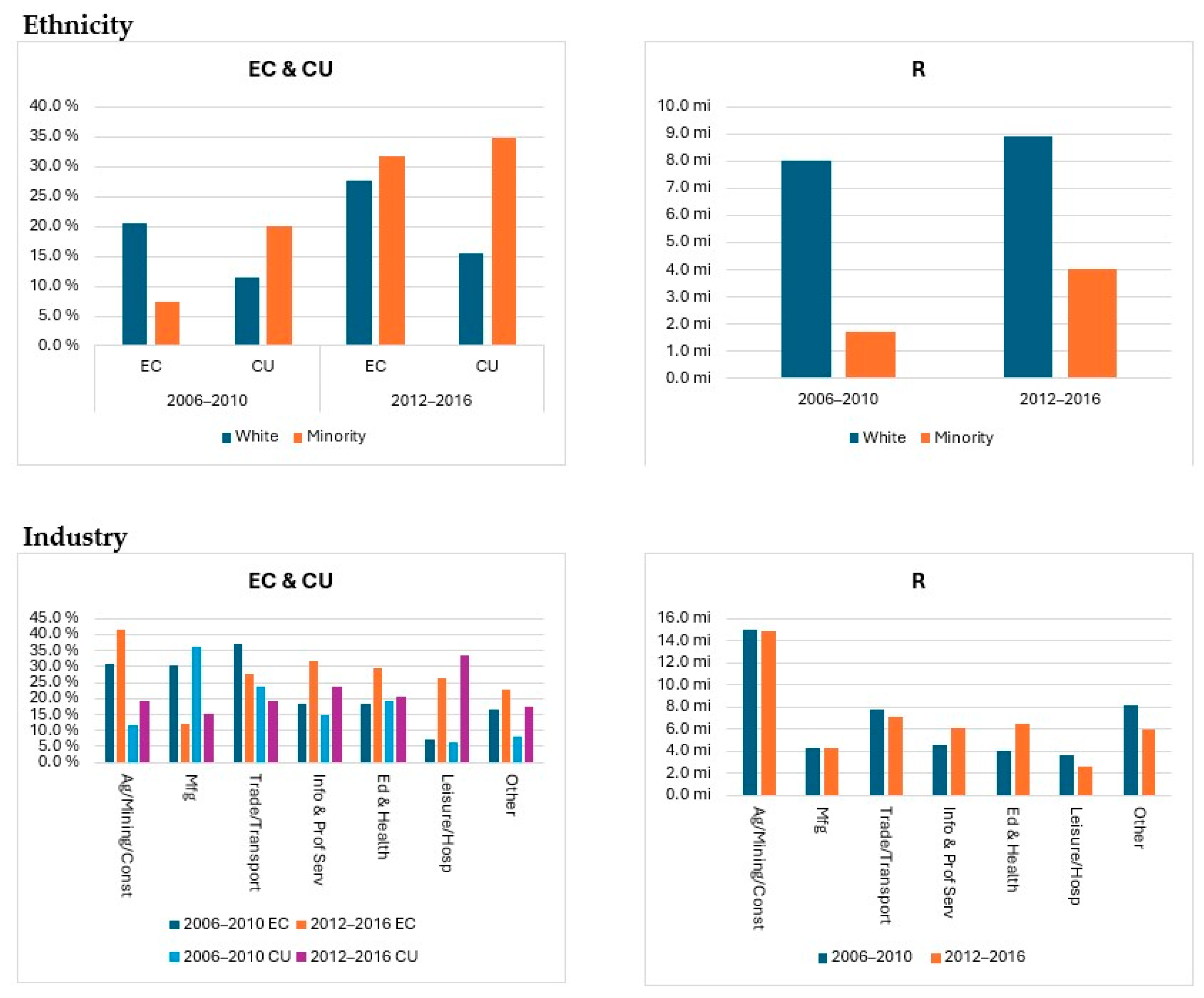Excess Commuting in Rural Minnesota: Ethnic and Industry Disparities
Abstract
1. Introduction
2. Literature Review
3. Methodologies
3.1. Study Area and Data
3.2. Method
4. Results and Discussion
4.1. Results
4.2. CTPP Data Limitations
4.3. Policy Implications
5. Conclusions and Future Studies
Author Contributions
Funding
Institutional Review Board Statement
Informed Consent Statement
Data Availability Statement
Conflicts of Interest
References
- Hamilton, B. Wasteful commuting. J. Polit. Econ. 1982, 90, 1035–1053. [Google Scholar] [CrossRef]
- White, M.J. Urban commuting journeys are not “wasteful”. J. Polit. Econ. 1988, 96, 1097–1110. [Google Scholar] [CrossRef]
- Horner, M.W.; Murray, A.T. Excess commuting and the modifiable areal unit problem. Urban Stud. 2002, 39, 131–139. [Google Scholar] [CrossRef]
- Pucher, J.; Renne, J.L. Rural mobility and mode choice: Evidence from the 2001 national household travel survey. Transportation 2005, 32, 165–186. [Google Scholar] [CrossRef]
- Espeland, S.; Rowangould, D. Rural travel burdens in the United States: Unmet need and travel costs. J. Transp. Geogr. 2024, 121, 104016. [Google Scholar] [CrossRef]
- Hole, A.R.; FitzRoy, F.R. Commuting in small towns in rural areas: The case of St Andrews. Int. J. Transp. Econ. 2005, 32, 77–92. [Google Scholar]
- Fletcher, C.N.; Garasky, S.B.; Jensen, H.H.; Nielsen, R.B. Transportation access: A key employment barrier for rural low-income families. J. Poverty 2010, 14, 123–144. [Google Scholar] [CrossRef]
- Parmaksız, D.; Ülkü, M.A.; Weigand, H. Investigating rural logistics and transportation through the lens of quadruple bottom line sustainability. Logistics 2024, 8, 81. [Google Scholar] [CrossRef]
- Izevbekhai, B.I.; Aydin, C.; Velasquez, R. Evaluation of Benefits of Drainable Base Systems Used by MnDOT; Report No. MN 2024-32; Minnesota Department of Transportation, Office of Research & Innovation: St. Paul, MN, USA, 2024. [Google Scholar]
- Current, D.; Motschke, C.; Serra, A., Jr.; Wyatt, G.; Zamora, D. Expanding Landowner Adoption of Snow Control Measures Through a Better Understanding of Landowner Knowledge, Attitudes and Practices; Report No. MN/RC 2019-44; Minnesota Department of Transportation, Office of Research & Innovation: St. Paul, MN, USA, 2019. [Google Scholar]
- Murphy, E.; Killen, J.E. Commuting economy: An alternative approach for assessing regional commuting efficiency. Urban Stud. 2011, 48, 1255–1272. [Google Scholar] [CrossRef]
- Kanaroglou, P.S.; Higgins, C.D.; Chowdhury, T.A. Excess commuting: A critical review and comparative analysis of concepts, indices, and policy implications. J. Transp. Geogr. 2015, 44, 13–23. [Google Scholar] [CrossRef]
- Simini, F.; González, M.C.; Maritan, A.; Barabási, A.-L. A universal model for mobility and migration patterns. Nature 2012, 484, 96–100. [Google Scholar] [CrossRef]
- Ren, Y.; Ercsey-Ravasz, M.; Wang, P.; González, M.C.; Toroczkai, Z. Predicting commuter flows in spatial networks using a radiation model based on temporal ranges. Nat. Commun. 2014, 5, 5347. [Google Scholar] [CrossRef]
- Persyn, D.; Torfs, W. A gravity equation for commuting with an application to estimating regional border effects in Belgium. J. Econ. Geogr. 2016, 16, 155–175. [Google Scholar] [CrossRef]
- Mazzoli, M.; Molas, A.; Bassolas, A.; Lenormand, M.; Colet, P.; Ramasco, J. Field theory for recurrent mobility. Nat. Commun. 2019, 10, 3895. [Google Scholar] [CrossRef] [PubMed]
- Hu, Y.; Wang, F. Decomposing excess commuting: A Monte Carlo simulation approach. J. Transp. Geogr. 2015, 44, 43–52. [Google Scholar] [CrossRef]
- Varga, L.; Tóth, G.; Neda, Z. Commuting patterns: The flow and jump model and supporting data. EPJ Data Sci. 2018, 7, 37. [Google Scholar] [CrossRef]
- McQuaid, R.W.; Chen, T. Commuting times: The role of gender, children and part-time work. Res. Transp. Econ. 2012, 34, 66–73. [Google Scholar] [CrossRef]
- Brown, D.L.; Champion, T.; Coombes, M.; Wymer, C. The migration-commuting nexus in rural England: A longitudinal analysis. J. Rural Stud. 2015, 41, 118–128. [Google Scholar] [CrossRef]
- Kim, C.; Sang, S.; Chun, Y.; Lee, W. Exploring urban commuting imbalance by jobs and gender. Appl. Geogr. 2012, 32, 532–545. [Google Scholar] [CrossRef]
- Kwan, M.-P.; Kotseve, A. Gender differences in commute time and accessibility in Sofia, Bulgaria: A study using 3D geo-visualization. Geogr. J. 2015, 181, 83–96. [Google Scholar] [CrossRef]
- Levin, L. How may public transport influence the practice of everyday life among younger and older people and how may their practices influence public transport? Soc. Sci. 2019, 8, 96. [Google Scholar] [CrossRef]
- Jang, W.; Yuan, F.; Lopez, J.J. Investigating sustainable commuting patterns by socio-economic factors. Sustainability 2021, 13, 2180. [Google Scholar] [CrossRef]
- Tao, X.; Fu, Z.; Comber, A.J. An analysis of modes of commuting in urban and rural areas. Appl. Spat. Anal. Policy 2019, 12, 831–845. [Google Scholar] [CrossRef]
- Green, M.B.; Meyer, S.P. An overview of commuting in Canada with special emphasis on rural commuting and employment. J. Rural Stud. 1997, 13, 163–175. [Google Scholar] [CrossRef]
- Fan, J.X.; Wen, M.; Kowaleski-Jones, L. Sociodemographic and environmental correlates of active commuting in rural America. J. Rural Health 2015, 31, 176–185. [Google Scholar] [CrossRef]
- Champion, T.; Coombes, M.; Brown, D.L. Migration and longer-distance commuting in rural England. Reg. Stud. 2009, 43, 1245–1259. [Google Scholar] [CrossRef]
- Antipova, A. Analysis of commuting distances of low-income workers in Memphis Metropolitan area, TN. Sustainability 2020, 12, 1209. [Google Scholar] [CrossRef]
- Ash, L.J. Excess Commuting and Its Relation to Urban Form in Ontario, Canada. Master’s Thesis, University of Windsor, Windsor, ON, Canada, 2017. Available online: https://hdl.handle.net/20.500.14776/7465 (accessed on 1 March 2025).
- Giménez-Nadal, J.I.; Velilla, J.; Ortega-Lapiedra, R. Differences in commuting between employee and self-employed workers: The case of Latin America. J. Transp. Geogr. 2024, 114, 103770. [Google Scholar] [CrossRef]
- Zhang, H.; Xu, S.; Liu, X.; Liu, C. Near ’real-time’ estimation of excess commuting from open-source data: Evidence from China’s megacities. J. Transp. Geogr. 2021, 91, 102929. [Google Scholar] [CrossRef]
- Kim, K.; Horner, M.W. Examining the impacts of the Great Recession on the commuting dynamics and jobs-housing balance of public and private sector workers. J. Transp. Geogr. 2021, 90, 102933. [Google Scholar] [CrossRef]
- Alexander, B.; Dijst, M. Professional workers @ work: Importance of work activities for electronic and face-to-face communications in the Netherlands. Transportation 2012, 39, 919–940. [Google Scholar] [CrossRef]
- Kersting, M.; Matthies, E.; Lahner, J.; Schlüter, J. A socio-economic analysis of commuting professionals. Transportation 2021, 48, 2127–2158. [Google Scholar] [CrossRef]
- Campisi, T.; Tesoriere, G.; Trouva, M.; Papas, T.; Basbas, S. Impact of teleworking on travel behaviour during the COVID-19 era: The case of Sicily, Italy. Transp. Res. Procedia 2022, 60, 251–258. [Google Scholar] [CrossRef]
- Elfering, A.; Igic, I.; Kritzer, R.; Semmer, N.K. Commuting as a work-related demand: Effects on work-to-family conflict, affective commitment, and intention to quit. Psych J. 2020, 9, 562–577. [Google Scholar] [CrossRef]
- Hambly, H.; Lee, J. The rural telecommuter surplus in Southwestern Ontario, Canada. Telecomm. Policy 2019, 43, 278–286. [Google Scholar] [CrossRef]
- Zhou, J.; Murphy, E.; Long, Y. Commuting efficiency gains: Assessing different transport policies with new indicators. Int. J. Sustain. Transp. 2018, 13, 710–721. [Google Scholar] [CrossRef]
- Niedzielski, M.A.; Hu, Y.; Stępniak, M. Temporal dynamics of the impact of land use on modal disparity in commuting efficiency. Comput. Environ. Urban Sys. 2020, 83, 101523. [Google Scholar] [CrossRef]
- Kim, C.; Choi, C. Towards sustainable urban spatial structure: Does decentralization reduce commuting times? Sustainability 2019, 11, 1012. [Google Scholar] [CrossRef]
- Jing, Y.; Hu, Y.; Niedzielski, M.A. Neighborhood divides: Where you live matters for commuting and its efficiency. Cities 2023, 132, 104091. [Google Scholar] [CrossRef]
- Ma, K.R.; Banister, D. Excess commuting: A critical review. Transp. Rev. 2006, 26, 749–767. [Google Scholar] [CrossRef]
- Hu, Y.; Li, X. Modeling and analysis of excess commuting with trip chains. Ann. Am. Assoc. Geogr. 2021, 111, 1851–1867. [Google Scholar] [CrossRef]
- Zhang, Y.; Zhang, Y.; Zhou, J. A novel excess commuting framework: Considering commuting efficiency and equity simultaneously. Urban Anal. City Sci. 2021, 48, 151–168. [Google Scholar] [CrossRef]
- Delbosc, A.; Currie, G. The spatial context of transport disadvantage, social exclusion, and well-being. J. Transp. Geogr. 2011, 19, 1130–1137. [Google Scholar] [CrossRef]
- Jain, M.; Korzhenevych, A.; Hecht, R. Determinants of commuting patterns in a rural-urban megaregion of India. Transp. Policy 2018, 68, 98–106. [Google Scholar] [CrossRef]
- Partridge, M.D.; Ali, K.; Olfert, M.R. Rural-to-urban commuting: Three degrees of integration. Growth Change 2010, 41, 303–335. [Google Scholar] [CrossRef]
- Ratcliffe, M.; Burd, C.; Holder, K.; Fields, A. Defining Rural at the U.S. Census Bureau; U.S. Census Bureau: Washington, DC, USA, 2016.
- Kures, M.; Deller, S.C. Growth in commuting patterns and their impacts on rural workforce and economic development. Econ. Dev. Q. 2023, 37, 54–63. [Google Scholar] [CrossRef]
- Paul, J. Work from home behaviors among U.S. urban and rural residents. J. Rural Stud. 2022, 96, 101–111. [Google Scholar] [CrossRef]
- Kaiser, N.; Barstow, C.K. Rural transportation infrastructure in low- and middle-income countries: A review of impacts, implications, and interventions. Sustainability 2022, 14, 2149. [Google Scholar] [CrossRef]
- Spey, I.-K.; Kupsch, D.; Bobo, K.S.; Waltert, M.; Schwarze, S. The Effects of road access on income generation. Evidence from an integrated conservation and development project in Cameroon. Sustainability 2019, 11, 3368. [Google Scholar] [CrossRef]
- Charlery, L.C.; Qaim, M.; Smith-Hall, C. Impact of infrastructure on rural household income and inequality in Nepal. J. Dev. Eff. 2015, 8, 266–286. [Google Scholar] [CrossRef]
- Lichter, D.T.; Parisi, D.; Taquino, M.C. Emerging patterns of Hispanic residential segregation: Lessons from rural and small-town America. Rural Sociol. 2016, 81, 483–518. [Google Scholar] [CrossRef]
- Smith, J.M. Racializing rural places through USDA home economics agricultural extension, 1965–1982. J. Rural Stud. 2024, 106, 103240. [Google Scholar] [CrossRef]
- Krumel, T.P.; Goodrich, C. Meatpacking working conditions and the spread of COVID-19. Appl. Econ. 2023, 55, 3637–3660. [Google Scholar] [CrossRef]
- Byttebier, K. COVID-19’s Impact on Labour. In COVID-19 and Capitalism: Success and Failure of the Legal Methods for Dealing with a Pandemic; Springer International Publishing: Cham, Switzerland, 2022; pp. 663–787. [Google Scholar]
- Mattson, J.; Peterson, D.; Hough, J.; Godavarthy, R.; Kack, D. Measuring the Economic Benefits of Rural and Small Urban Transit Services in Greater Minnesota; Report No. MN 2020-10; Minnesota Department of Transportation, Office of Policy Analysis, Research & Innovation: St. Paul, MN, USA, 2020. [Google Scholar]
- Mattson, J.; Quayson, B.; Ebrahimi, Z.D. Comparing Public Transportation Services for Rural States in the Upper Midwest and Great Plains Region; Report No. 320; Upper Great Plains Transportation Institute: Fargo, ND, USA, 2023. [Google Scholar]
- Frost, M.; Linneker, B.; Spence, N. Excess or wasteful commuting in the selection of British cities. Transp. Res. Part A Policy Pract. 1998, 32, 529–538. [Google Scholar] [CrossRef]
- Šťastná, M.; Vaishar, A. The relationship between public transport and the progressive development of rural areas. Land Use Policy 2017, 67, 107–114. [Google Scholar] [CrossRef]
- Velaga, N.R.; Nelson, J.D.; Wright, S.D.; Farrington, J.H. The potential role of flexible transport services in enhancing rural public transport provision. J. Public Transp. 2012, 15, 111–131. [Google Scholar] [CrossRef]
- Buehler, R. Promoting public transportation: Comparison of passengers and policies in Germany and the United States. Transp. Res. Rec. 2009, 2110, 60–68. [Google Scholar] [CrossRef]
- Renkow, M.; Hoover, D. Commuting, migration, and rural-urban population dynamics. J. Reg. Sci. 2000, 40, 261–287. [Google Scholar] [CrossRef]




| Name | Type * |
|---|---|
| Blue Earth | Entirely Urban |
| Brown | Town/rural mix |
| Cottonwood | Town/rural mix |
| Faribault | Town/rural mix |
| Jackson | Town/rural mix |
| Le Sueur | Urban/town/rural mix |
| Martin | Town/rural mix |
| Nicollet | Urban/town/rural mix |
| Nobles | Town/rural mix |
| Rock | Urban/town/rural mix |
| Sibley | Urban/town/rural mix |
| Waseca | Urban/town/rural mix |
| Watonwan | Town/rural mix |
| Category | Description |
|---|---|
| 1 | Total persons |
| 2 | White alone, not Hispanic/Latino |
| 3 | Other |
| Category | Description | New Label |
|---|---|---|
| 1 | Total, all Industries | All |
| 2 | Agriculture, Forestry, Fishing and Hunting, and Mining; Construction; Armed Forces | Ag, Mining, & Const |
| 3 | Manufacturing | Mfg |
| 4 | Wholesale Trade; Retail Trade; Transportation and Warehousing, and Utilities | Trade & Transport |
| 5 | Information; Finance, Insurance, Real Estate and Rental, and Leasing; Professional, Scientific, Management, Administrative, and Waste Management Services | Info & Prof. Services |
| 6 | Educational, Health, and Social Services | Ed & Health |
| 7 | Arts, Entertainment, Recreation, Accommodation, and Food Services | Leisure & Hospitality |
| 8 | Other services (except Public Administration); Public Administration | Other |
| 2006–2010 | 2012–2016 | |||||||||||
|---|---|---|---|---|---|---|---|---|---|---|---|---|
| Category | Tmin | Tobs | Tmax | EC (%) | R | CU (%) | Tmin | Tobs | Tmax | EC (%) | R | CU (%) |
| Ethnicity | ||||||||||||
| White | 3.1 | 6.0 | 54.0 | 49.0 | 50.9 | 5.8 | 3.1 | 6.7 | 55.0 | 54.0 | 51.9 | 7.0 |
| Minority | 2.7 | 4.9 | 52.0 | 43.6 | 49.2 | 4.3 | 3.0 | 5.4 | 64.4 | 43.7 | 61.4 | 3.8 |
| Industry | ||||||||||||
| Ag/Mining/Const | 3.8 | 6.4 | 70.2 | 39.6 | 66.3 | 3.8 | 3.8 | 6.9 | 71.4 | 44.6 | 67.5 | 4.6 |
| Mfg | 3.9 | 6.6 | 42.3 | 40.3 | 38.3 | 6.9 | 4.7 | 8.4 | 44.3 | 44.1 | 39.7 | 9.3 |
| Trade/Transport | 3.3 | 5.9 | 55.5 | 43.1 | 52.2 | 4.8 | 3.7 | 7.1 | 57.6 | 47.9 | 53.9 | 6.3 |
| Info & Prof Serv | 3.5 | 5.9 | 52.8 | 41.1 | 49.3 | 4.9 | 3.2 | 6.3 | 51.5 | 48.9 | 48.3 | 6.4 |
| Ed & Health | 3.1 | 6.0 | 53.9 | 49.5 | 50.8 | 5.9 | 3.1 | 6.6 | 52.1 | 52.7 | 49.0 | 7.1 |
| Leisure/Hosp | 2.5 | 4.0 | 50.4 | 37.2 | 47.9 | 3.1 | 2.6 | 4.8 | 53.8 | 45.7 | 51.2 | 4.3 |
| Other | 3.5 | 6.7 | 57.7 | 48.0 | 54.2 | 5.9 | 3.6 | 6.8 | 58.2 | 46.4 | 54.5 | 5.8 |
| All | 3.0 | 6.0 | 53.9 | 50.1 | 50.9 | 5.9 | 3.0 | 6.6 | 55.5 | 54.5 | 52.5 | 6.9 |
| 2006–2010 | 2012–2016 | |||||||||||
|---|---|---|---|---|---|---|---|---|---|---|---|---|
| Category | Tmin | Tobs | Tmax | EC (%) | R | CU (%) | Tmin | Tobs | Tmax | EC (%) | R | CU (%) |
| Ethnicity | ||||||||||||
| White | 3.5 | 4.4 | 11.5 | 20.6 | 8.0 | 11.4 | 3.6 | 5.0 | 12.5 | 27.7 | 8.9 | 15.4 |
| Minority | 4.2 | 4.5 | 5.8 | 7.4 | 1.7 | 20.1 | 3.0 | 4.4 | 7.0 | 31.7 | 4.0 | 34.7 |
| Industry | ||||||||||||
| Ag/Mining/Const | 3.9 | 5.7 | 18.9 | 30.9 | 15.0 | 11.7 | 4.0 | 6.9 | 18.9 | 41.7 | 14.9 | 19.2 |
| Mfg | 3.6 | 5.1 | 7.9 | 30.3 | 4.3 | 36.0 | 4.7 | 5.4 | 9.0 | 12.1 | 4.3 | 15.1 |
| Trade/Transport | 3.2 | 5.0 | 10.9 | 36.9 | 7.8 | 23.8 | 3.6 | 5.0 | 10.7 | 27.6 | 7.1 | 19.3 |
| Info & Prof Serv | 3.0 | 3.6 | 7.4 | 18.2 | 4.5 | 14.7 | 3.1 | 4.6 | 9.2 | 31.6 | 6.1 | 23.6 |
| Ed & Health | 3.4 | 4.1 | 7.4 | 18.5 | 4.0 | 19.2 | 3.2 | 4.6 | 9.7 | 29.7 | 6.5 | 20.8 |
| Leisure/Hosp | 2.9 | 3.1 | 6.6 | 7.4 | 3.7 | 6.3 | 2.4 | 3.3 | 5.0 | 26.3 | 2.6 | 33.6 |
| Other | 3.3 | 3.9 | 11.4 | 16.5 | 8.1 | 8.0 | 3.6 | 4.6 | 9.6 | 22.8 | 6.0 | 17.5 |
| All | 3.1 | 4.4 | 10.9 | 30.5 | 7.9 | 17.2 | 3.0 | 4.8 | 11.5 | 36.9 | 8.5 | 21.0 |
Disclaimer/Publisher’s Note: The statements, opinions and data contained in all publications are solely those of the individual author(s) and contributor(s) and not of MDPI and/or the editor(s). MDPI and/or the editor(s) disclaim responsibility for any injury to people or property resulting from any ideas, methods, instructions or products referred to in the content. |
© 2025 by the authors. Licensee MDPI, Basel, Switzerland. This article is an open access article distributed under the terms and conditions of the Creative Commons Attribution (CC BY) license (https://creativecommons.org/licenses/by/4.0/).
Share and Cite
Jang, W.; Lopez, J.J.; Yuan, F. Excess Commuting in Rural Minnesota: Ethnic and Industry Disparities. Sustainability 2025, 17, 7122. https://doi.org/10.3390/su17157122
Jang W, Lopez JJ, Yuan F. Excess Commuting in Rural Minnesota: Ethnic and Industry Disparities. Sustainability. 2025; 17(15):7122. https://doi.org/10.3390/su17157122
Chicago/Turabian StyleJang, Woo, Jose Javier Lopez, and Fei Yuan. 2025. "Excess Commuting in Rural Minnesota: Ethnic and Industry Disparities" Sustainability 17, no. 15: 7122. https://doi.org/10.3390/su17157122
APA StyleJang, W., Lopez, J. J., & Yuan, F. (2025). Excess Commuting in Rural Minnesota: Ethnic and Industry Disparities. Sustainability, 17(15), 7122. https://doi.org/10.3390/su17157122





